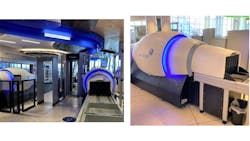TSA Checkpoints Begin Using 3D Checkpoint Scanners to Improve Explosives Detection
On April 1, the Transportation Security Administration (TSA) announced that it has installed computed tomography (CT) checkpoint scanners that provide 3D imaging at TSA checkpoints at Frederick Douglass Grater Rochester International Airport (ROC), Rochester, New York.
Six CT X-ray units are installed at one checkpoint at the airport and are expected to provide critical explosives detection capabilities in each checkpoint lane.
The systems used apply algorithms to detect explosives by creating a 3D image that can be viewed and rotated 360 degrees on three axes for thorough visual image analysis by a transportation security officer. If a carry-on bag requires further screening, a TSA officer will inspect the bag manually to ensure it does not contain a threat item.
According to the TSA, the technology used for the checkpoint X-ray scanning equipment is similar to that used in the medical field. The TSA currently uses technology that creates 2D images, but the CT technology provides enhanced detection of threat items. Like existing CT technology used for checked baggage, the machines create such a clear picture of a bag’s contents that computers can automatically detect explosives, including liquids. The TSA hopes to keep laptops and 3-1-1 liquids inside a carry-on bag during checkpoint screening in the future.
This new technology creates such a clear image of a bag’s contents, according to the TSA, that the system can automatically detect explosives, including liquids, by shooting hundreds of images with an X-ray camera spinning around the conveyor belt to provide TSA officers with the three-dimensional views of the contents of a carry-on bag.
The TSA hopes that checkpoint CT technology will result in fewer bag checks. Passengers using these machines at ROC will be permitted to leave their laptops and other electronic devices in their carry-on bags.
Continued Investment
In March 2022, the TSA awarded two orders for a combined total value of up to $781.2 million to Analogic to procure and maintain base and full-size CT X-ray systems for carry-on items at TSA checkpoints.
According to the TSA, the awards include up to 469 base and 469 full-size systems. Full-size CT systems feature fully automated screening lanes with parallel divestiture stations, automated bin return, and high threat containment to allow for greater passenger throughput. The TSA anticipates beginning deployment of base and full-size systems to airport checkpoints in the summer of 2022.
In August 2021, TSA announced the award of $198 million to Analogic Corporation to procure mid-size CT X-ray systems. Those systems are currently being installed at TSA checkpoints across the country.
